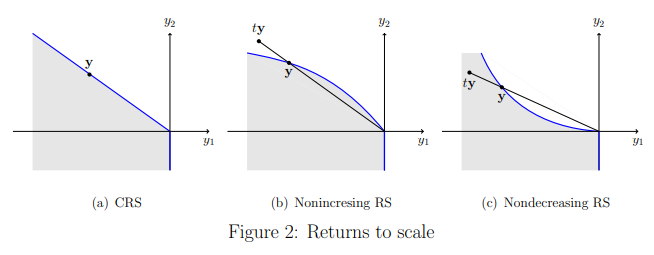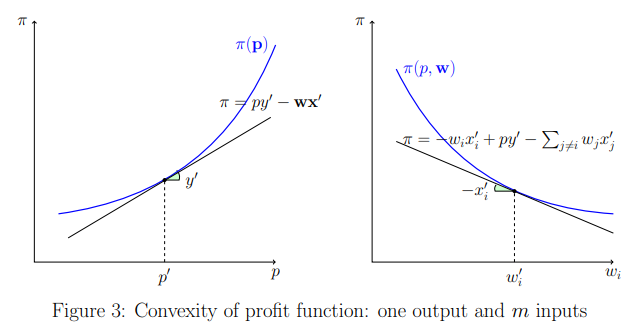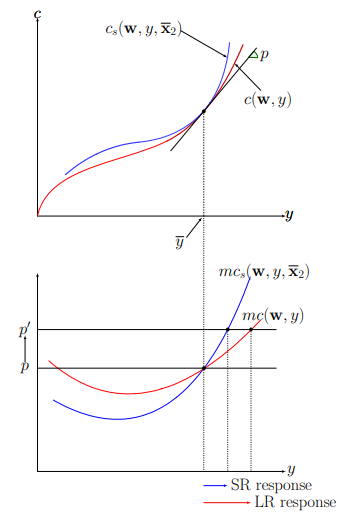Producer Theory
Oh, Hyunzi. (email: wisdom302@naver.com)
Korea University, Graduate School of Economics.
2024 Spring, instructed by prof. Koh, Youngwoo.
Production
- if
- if
- if
- Assume
- Assume
- set of all feasible production plans, given technology.
For simplicity, we assume one output and
- set of all input bundles
- note that
- set of all input bundles
- maximized
- maximized
- inputs required to product
- inputs required to product

Let there be one output and two inputs, and let
- transformation function:
- production set:
- input requirement set:
- production function:
- Isoquant inputs:
- production set when
Elasticity of Substitution
Elasticity of Substitution between inputs
For CES production function
For CES production function
- if
- if
- if
Proof.Let the CES function be
- If
- Let
- by taking log on both sides,
- by the L'hospital's law,
- thus we have
- by taking exponential on both sides to get the original function,
- by taking log on both sides,
- Let
- Similar to the prior proof, first take log on both sides:
- Let
- where the last equation holds since
- therefore, we have
- Similar to the prior proof, first take log on both sides:
this completes the proof. □
Properties of Production Sets
Let
- No free lunch: no inputs, no outputs
- Possibility of inaction: sunk cost is ignored
- Free disposal: no cost to through away the remaining inputs or outputs
A production function
- constant returns to scale (crs) if
- increasing returns to scale (irs) if
- decreasing returns to scale (drs) if
- non-increasing returns to scale (nirs) if
- non-decreasing returns to scale (ndrs) if

If
Proof.Since
Profit Maximization
Assume:
- competitive market: firms are the price takers
Profit Maximization Problem (PMP)
For
Proof.From PMP,
Now, let there be one output and
this completes the proof. □
Profit Function
Let
In the case of one output and
If
- If
Proof.
- Let
- WTS#1
- by Def (convex function)Def (convex function), WTS
this completes the proof. □

For all
Proof.Assume
If
Proof.WTS
By the ^b7e327Theorem 10 (Hotelling's lemma), we have
Since
Furthermore, let
Cost Minimization
Cost Minimization Problem (CMP)
for
Proof.From CMP,
Therefore, by letting
Properties of Cost Function
Let
and the cost function of the firm is
If
- homogeneous of degree 1 in
- strictly increasing in
- concave in
- continuous in
Proof.The proof is identical to Basic Consumer Theory > ^6bcfb6Basic Consumer Theory > Proposition 29 (Properties of the Expenditure Function).
- WTS
- WTS
- First we show the strictly increasing in
- RTA: ASM
- let
- since
- this contradicts to the assumption that
- RTA: ASM
- Next we show the nondecreasing in
- ASM:
- then we have
- ASM:
- First we show the strictly increasing in
- for a fixed
- as
- therefore, we have
- thus
- as
- This directly follows from Berge's Maximum TheoremBerge's Maximum Theorem.
- note that
- if
- note that
this completes the proof. □
For all
Proof.Assume
Solving PMP and CMP
Given the cost function
Let the Cobb-Douglas production function be
Proof.We first derive the cost function from CMP, and second, we derive the factor demand function and the profit function from PMP.
From CMP:
From the above equality, we have
From PMP:
Case 1)
the supply function is
Case 2)
From F.O.C.,
- if
- if
- if
Case 3)
From F.O.C.,
this completes the proof. □
Short-run and Long-run CMP
Assume that some inputs
Let
- long-run (average) cost curve is the lower envelope of the short-run (average) cost curves.
- the response of output to its price change is greater in the long-run than in the short-run.
Proof.for given some
therefore, the first and second order conditions imply

Duality
Let
This theorem implies
- cost function summarizes all of the economically relevant aspects of the technology.
- the technology recovered from the cost function is essentially the same as the true technology.
Proof.First, by definition of
thus we concludes that
- If any function
- If any function
Consider
Proof.First, by applying ^7d55d9Theorem 15 (Shephard's lemma(cost function)),